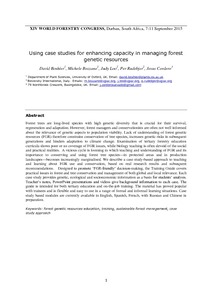Resource information
Forest trees are long-lived species with high genetic diversity that is crucial for their survival,
regeneration and adaptation. However, forest managers and conservationists are often not well informed
about the relevance of genetic aspects to population viability. Lack of understanding of forest genetic resources (FGR) therefore constrains conservation of tree species, increases genetic risks in subsequent generations and hinders adaptation to climate change. Examination of tertiary forestry education curricula shows poor or no coverage of FGR issues, while biology teaching is often devoid of the social and practical realities. A vicious cycle is looming in which teaching and understanding of FGR and its importance to conserving and using forest tree species in protected areas and in production landscapes becomes increasingly marginalised. We describe a case study based approach to teaching and learning about FGR use and conservation, based on real research results and subsequent recommendations. Designed to promote ‘FGR-friendly’ decision-making, the Training Guide covers practical issues in forest and tree conservation and management of both global and local relevance. Each case study provides genetic, ecological and socioeconomic information as a basis for students’ analysis. Teacher’s notes, PowerPoint presentations and videos give background information to each case. The guide is intended
for both tertiary education and on-the-job training. The material has proved popular with trainees and is flexible and easy to use in a range of formal and informal learning situations. Case study based modules are currently available in English, Spanish, French, with Russian and Chinese in preparation



